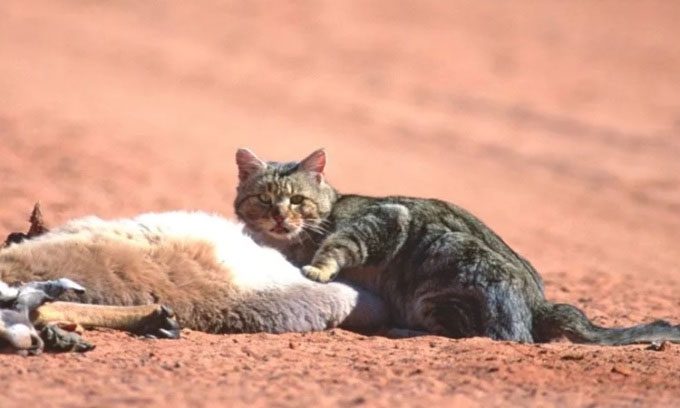Scientists propose using a special gene editing technology to tackle the overwhelming feral cat populations that threaten native wildlife.
Feral cats arrived in Australia with European colonizers and frequently kill native mammals, birds, and reptiles, including the woylie, the eastern barred bandicoot, and even penguins. Currently, the feral cat population exceeds 6 million and is responsible for the extinction of at least 28 species across Australia, while also threatening countless others. This has prompted several control measures, including the distribution of poison, trapping, and enforcing cat restrictions indoors. Postdoctoral researcher Ellen Cottingham at the University of Melbourne proposed using gene drive technology to control the feral cat population, as reported by Newsweek on November 28.

A feral cat feeding on a roadkill animal in Australia. (Photo: iStock).
“Gene drive technology spreads modified genes throughout a species by ensuring they are inherited from one generation to the next, ultimately leading to an entire population with edited genetic traits,” explained Andrew D. Maynard, a professor of Advanced Technology Transformation at the University of Arizona. “This technique is specifically designed for sexually reproducing species, operating by ensuring that each offspring inherits the modified genetic traits.”
The genes are transmitted to every offspring, rather than just a few, as is the case with typical genetic traits like eye color. This ensures that a specific gene spreads particularly rapidly through the population. Therefore, this approach is very useful for dealing with invasive species, as it can disseminate genes that induce sterility or limit the growth of the species.
The process is carried out using CRISPR gene editing tools, which allow for the cutting of specific genes in the genetic code of a species and replacing them with other genes. Additionally, a segment of genetic code is added to continue the search-and-replace process in the DNA of any offspring. This operation is akin to inserting a small genetic algorithm into the offspring to continuously search for the gene sequence that needs replacement. As a result, when two feral cats mate, and one has undergone gene editing, the search-and-replace algorithm will ensure that all offspring inherit the modified gene. In this way, an entire species could potentially be genetically altered or even eradicated if sterilization genes are inherited.
This technology has previously been tested on mosquitoes, helping to reduce their ability to transmit malaria. Gene drive has also been successfully implemented in mice in 2019, but since then, no other mammalian species has been successfully modified. There are many criticisms of this method, including concerns that the edited genes could spread to important non-target species, even giving one species an unintended advantage that makes it harder to eradicate. Therefore, before proceeding with gene drives in the wild, researchers need to conduct years of testing to ensure there are no errors.
Moreover, Cottingham emphasized that current estimates of the time required for gene drives to take effect in invasive populations are not very optimistic, potentially taking decades. For instance, in rabbits, it takes 17 years for gene drive to spread through half the population in Australia.



















































